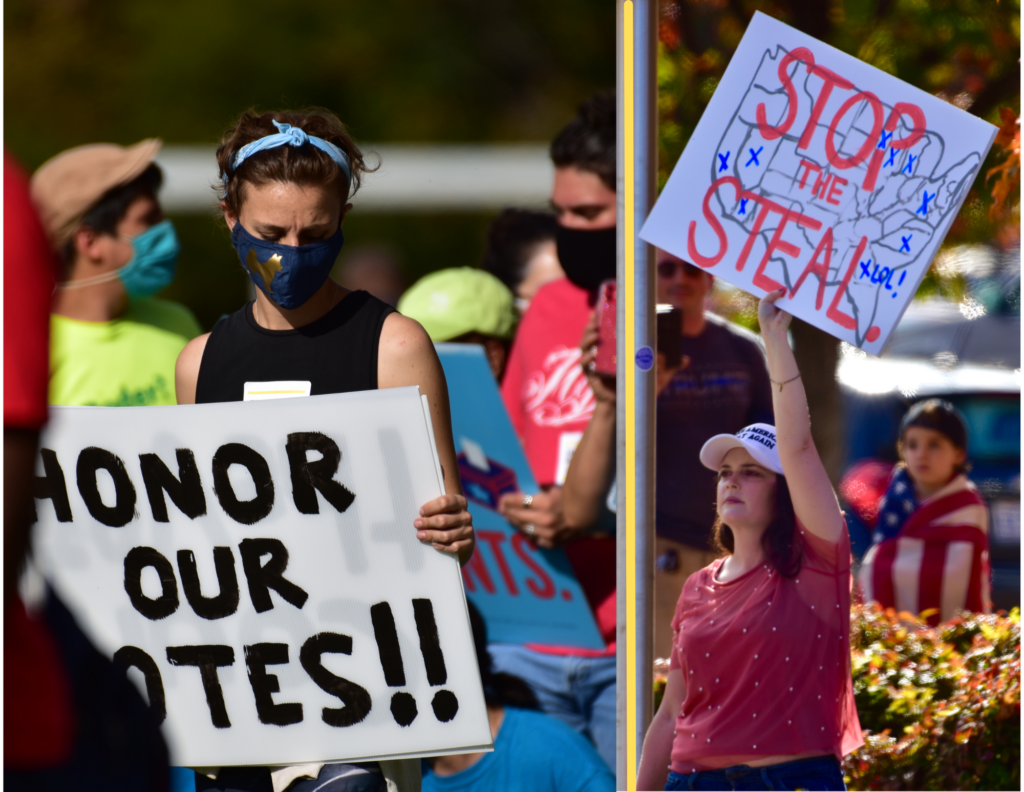The 2020 presidential election saw the clash between two broad fronts: advocates of a white republic hell-bent on impeding democracy versus an array of constituencies and organizations that recognized Trump as a threat to democracy and racial justice, as they understood both. The latter was energized by both Trump’s attacks against people of color in the U.S. and across the globe, and the racial justice demonstrations that swept the country following the murder of George Floyd. The anti-Trump front included many groups who had previously abstained from or had been ambivalent about electoral battles.
Some sectors of the monumental and crucial effort to remove Trump from office believed that his loss of the presidency and the Democrats winning narrow majorities in Congress would open the door for the left to go on the offensive and win major victories in a relatively short time.
This view unfortunately missed two things. First, it overlooked the predominance and strength of the right and didn’t appreciate what a protracted struggle it would take to defeat them. Second, it overestimated the strength of the progressive forces and underestimated the strength of some of the political forces in the much-needed front that are center to center-left on the political spectrum. The existence of this view, in part, prevented the broad left from working off a strategy that would keep us galvanized, united, and focused beyond Trump’s removal from office.
We are in a ‘high-stakes political period’ during which the electoral arena is a key site of battle but not the only one.
To get re-focused and right-sized in our strategic thinking, we need to put the current political moment in a broader political and historical context. We are living in a time like no other in recent memory. The combination of the pandemic, hyper political polarization, and compounding crises place us at a critical junction: entrenchment of white, minority rule or motion toward a multiracial democracy. We are in a “high-stakes political period” during which the electoral arena is a key site of battle but not the only one. Given what is on the line, we do not have the luxury of treating election work on a case-by-case basis. We instead should begin to see electoral work as integral to building governing power and consolidating a left flank within a broader front to defeat the right.
Why a high-stakes political period?
There are four key elements that shape the high stakes of this moment.
First, what I think can be accurately termed the “New Confederacy” (the predominantly white, cross-class united front that is made up of the most reactionary organizations, individuals, and capitalists and uses the Republican Party as their political instrument) poses a bigger threat to a more progressive way of life than any other political force in the U.S. in the past 40 years and counting. That threat is imminent and makes them the main enemy that needs to be defeated to end this phase of struggle and begin another.
Second, the only thing that can defeat them is a well-constructed self-conscious bloc (aka a united front for multiracial democracy) made up of an array of political forces who have many differences but share an interest in defeating the New Confederacy. The Left needs to help build such a front with eyes wide open: this is a protracted struggle and the different participants in this united front are contending over what “multiracial democracy” means and how it should be manifested.
This is a protracted struggle and the different participants in this united front are contending over what ‘multiracial democracy’ means.
Third, the neoliberal order that dominated U.S. economics and politics since Reagan’s ascent in the 1980s is declining. The influence of neoliberalism on center and center-left coalitions within the Democratic Party is in decline, but what will replace that model is unclear. The current crises and political polarization, which are global in nature, are animating sections of the population that were previously uninvolved in politics; they have swung into motion, both on the left and on the right. Whether the energy of those sectors for politics can be maintained, and in what direction, will have a huge impact on which path the country takes.
Finally, the New Confederacy and the Pro-Democracy United Front are right now locked in what Mike Davis termed “trench warfare.” Neither side is able to decisively dominate in order to implement their agenda on a nationwide scale.
What 2020 revealed
The 2020 elections were a wake-up call that clearly illuminated the political crossroads at which our country sits. The polarization between white minority rule and multiracial democracy was on full display.
We saw a record number of people get turned out to vote for Biden by neighbors, friends, celebrities, unions, and organizations. Then Trump and his acolytes predictably made an attempt to overturn the election results in states Biden won. The polarization continued to show when poll workers and election officials blocked these attempts. And many of us have images of the (failed) insurrection at the Capitol that saw a violent clash between insurrectionists and law enforcement.
These instances and more point to two very different directions that this country could take, depending on who is able to gain the advantage, go on the offensive and start implementing their program. One road leads to massive political repression of the majority, climate and science denial, and death. The other leads to greater possibility of expanding rights, addressing climate change, and providing conditions for the left to live to fight another day towards a more egalitarian society.
Under capitalism, different possibilities
Either program, white minority rule or multiracial democracy, would be carried out by a new consensus that would still remain under capitalism. Still, there is an extremely sharp contrast between these two roads. White minority rule would likely bring strict limits on social/government support, with that reserved for “deserving” or “true” citizens; severe government restrictions on women’s and LGBTQ+ peoples’ rights; investments in and deployment of a more militarized state; an “America First” policy that would, among other things, “protect deserving citizens”; and support for a rapacious fossil fuel industry that threatens the survival of the planet.
The anti-Trump bloc is less united on a program than the New Confederacy. A multiracial pro-democracy agenda could include an expanded role for the federal government in providing federal programs and funding to everyday people; an expanded use of the federal government to supersede states’ rights when they impinge upon or cut off the rights of people of color, workers, etc. (e.g., HR 1 would have done this in regards to voting rights); more voting, social, and economic rights for more residents in the country.
Exactly how far-reaching positive reforms would be, and how much structural change could be accomplished, will depend on the relative strength of the different wings of the front that defeats the right. If the left grows strong enough, we could force adoption of change on a scale that both improves the lives of the majority and increases the power of the multiracial working class and its closest allies. This could then take us to a new stage of struggle in the fight to overcome capitalism. However, overcoming capitalism is not on the near-term agenda.
What does this mean for the Left and progressives?
Over the course of 2021, many leftists, progressives, and liberal establishment actors took on a fatalist view of the prospects of overcoming the obstacles to weakening (not defeating) the main enemy in the 2022 elections or beyond. In states where the right dominates with governing power, did they draw political maps even more in their favor? Yes. Is the Republican Party utilizing the filibuster to block sweeping legislation that would benefit most people? Yes. Are Republican-dominated state legislatures passing bills to simultaneously strengthen their ability to throw out and replace election results they deem unfavorable? Yes. Is right-wing extra-judicial violence becoming an increasing feature of our political landscape? Yes.
All of the above and other realities about the obstacles we face are true, and we must not ignore them. However, we should recognize some of the advantages that we can use to mount an effective fight to not be completely overrun by the right. And, if we go about our work building strategic, programmatic, and organizational cohesion, we can eventually leverage our advantages to see the pro-democracy forces go on the offensive.
If we go about our work building strategic, programmatic, and organizational cohesion, we can eventually leverage our advantages to see the pro-democracy forces go on the offensive.
First, we have been building, and continue to build, more statewide independent electoral vehicles with the aim of defeating the right and building political and governing power. This has been accompanied by a few national formations coming together or reorienting themselves that center racial, gender, and worker justice through the use of street heat and elections e.g., The Frontline, Seed the Vote, and UNITE HERE.
Second, the New Confederacy has intentionally abandoned the majority of the population in pursuit of their white minority rule. This leaves a variety of political forces and millions of people for us to organize into the united front to defeat them. Some of the forces and people agree with a lot of our positions and some don’t, but we share a common political interest in defending and expanding democracy in the United States.
Finally, although we faced substantial obstacles to engaging in the political process in 2020 (e.g., voter suppression laws, partisan/racial gerrymandering, etc.), the right did not take decisive and sustained control of Congress, and the Democratic Party was able to win the presidential election. This is proof, but not a guarantee, that we can overcome such impediments.
We need to be a part of shaping what the new consensus on the path of multiracial democracy should look like as a part of our fight against the political right and their agenda—and not cede this critical task to centrist and conservative pro-democracy forces.
The tasks ahead of us are arduous and there are no guarantees that we will succeed. There are no political inevitabilities. The immediate future of this country is far from being determined. Therefore, we need to be strategizing and fighting based on that fact. Otherwise, in this high-stakes political period, we risk completely losing our political possibilities and hopes for a future where the planet is protected and the rights and power of the oppressed are expanded.
Did you enjoy this article?
We're in the middle of our annual fund drive, and this year we're building our own internal infrastructure for subscriptions, meaning more of every dollar pledged goes to fulfilling our mission. Subscribe today to support our work and be a part of Convergence's next evolution.

